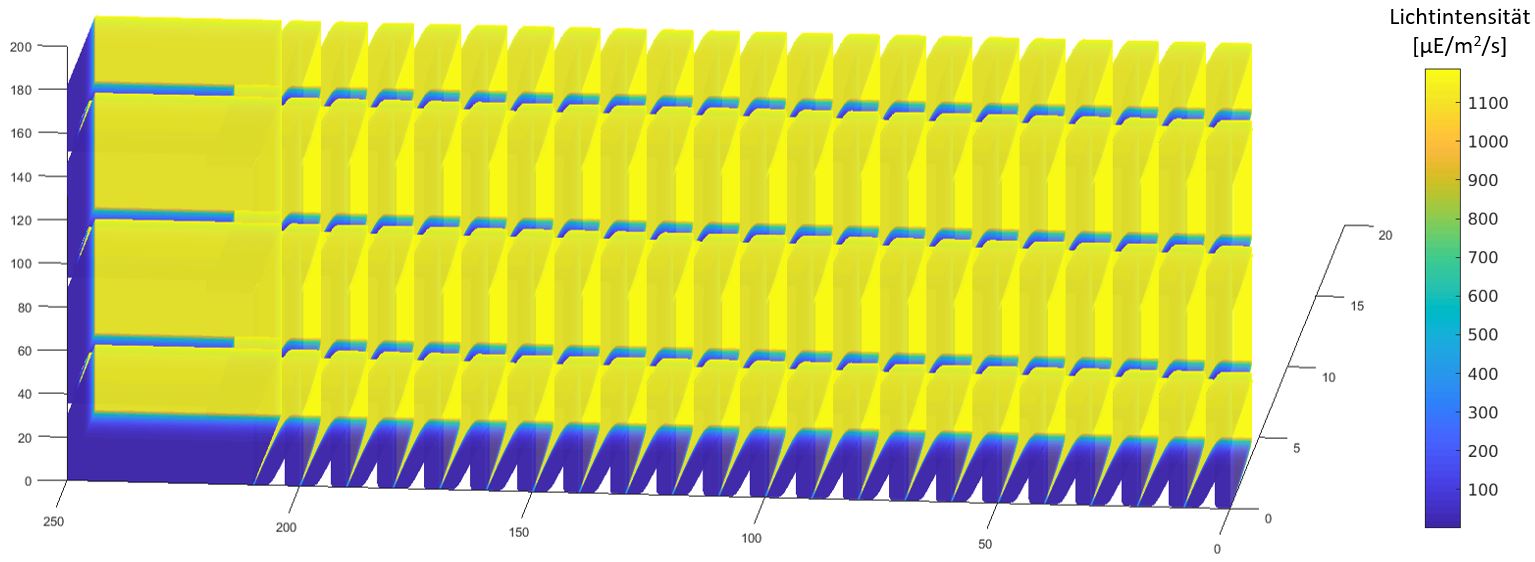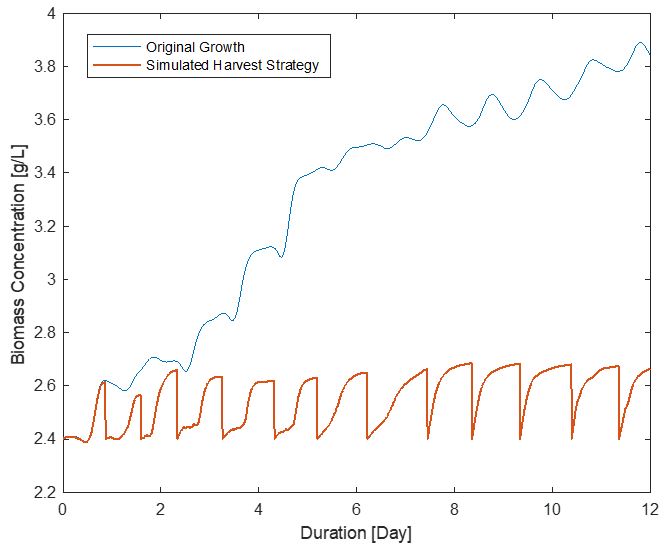Microalgae produce a variety of interesting ingredients and are therefore an ideal source for food, feed, cosmetics and fine chemicals. Although the basic mechanism of microalgae growth has been well studied, there are only a few mathematical models that can be used to model microalgae growth. Such models are particularly important for the large‑scale cultivation of microalgae and serve as a basis for a robust, predictive control system. An essential component of this system are algorithms that enable automated optimization of microalgae growth. So‑called machine learning has been widely used for prediction and optimization in different areas. To predict the growth behavior of the microalgae Phaeodactylum tricornutum in outdoor cultivation, so-called Support Vector Machines (SVM) were used. The results show that the SVM‑based model can predict the growth rate of Phaeodactylum tricornutum with a correlation coefficient of 88 percent. At the same time, a model with Monod kinetics yields a correlation coefficient of 82 percent. These two models will be further validated on both laboratory and pilot scale in order to establish a model‑predictive control for microalgae production.
Machine learning for algae cultivation

The needs of climate and environmental protection as well as the growing world population contribute to the fact that our economic system based on fossil resources is reaching its natural limits. With the Paris Climate Change Convention 2015, the international community has adopted a consensus to reduce the emission of greenhouse gases and environmental degradation. One way to counteract these problems is the use of microalgae, which use carbon dioxide as a source of carbon in order to grow. Cultivation in aqueous media also offers the possibility of saving agricultural land.
Microalgae produce a variety of substances with high value-added potential such as health-promoting omega‑3 fatty acids, carotenoids with antioxidant effects, pigments or polymeric storage substances. Therefore, they are an excellent sustainable source for the production of food, cosmetics, chemicals, pharmaceuticals and biofuels. Because of economic and ecological aspects, microalgae should be cultivated outdoors and on a large scale, using natural daylight as an energy source. The cultivation of microalgae was carried out at Fraunhofer IGB in so‑called flat panel airlift bioreactors (FPA). The major challenge here is that no robust and proven fully automated control system for the algae reactors has yet been established. This is mainly due to the lack of models that can control the algae growth and product formation in their cells.
The aim of the research work at Fraunhofer IGB is to introduce data‑based algorithms – generated by machine learning methods – to control the cultivation of algae in order to develop an economical, ecological and robust algae production process on an industrial scale. To achieve this goal, we are developing data‑driven models not only for efficient production of algal biomass but also for their intracellular products.
A reliable model will be developed that can well describe and predict algae growth for the automated and robust control of algae production processes. Data‑based control is not yet widely applied to algae cultivation as in other areas such as fluid dynamics and bioinformatics. Most of the modeling of algae growth has been successfully completed at Fraunhofer IGB.
Concept and results
The modeling and control of the cultivation of microalgae is known to be more complex than that of bacteria or yeasts. This is mainly due to its complex growth behavior and the lack of robust online monitoring methods for the growth of microalgae.
Improving monitoring of algae growth
The most popular method for monitoring the growth of microalgae is the OD (optical density) sensor, which measures the light adsorption, scattering caused by algae cells to calculate the biomass concentration. However, algae cells can change their size, shape and pigment content under different growth conditions, which has a major effect on the accuracy of measurements with the OD sensor. The other challenge in the cultivation of microalgae is the big difference of the growth behavior
in the laboratory and outdoors, as the conditions for large‑scale outdoor cultivation are much more complicated than in the laboratory. Therefore, our focus is on improving online monitoring and modeling of large‑scale microalgae cultivation with data‑driven methods.
To improve online monitoring, we are already optimizing the calibration of existing OD sensors with cultivation data under different conditions. However, OD sensors are very expensive and require an enormous investment for large‑scale algae cultivation. For this reason, we are also developing other methods, for example using camera, RGB and soft sensors to estimate the biomass concentration. The goal is to develop a robust, cost-effective online monitoring system for the growth of microalgae with a minimum number of sensors in the cultivation system.
Modeling of algae growth
Besides monitoring, modeling the growth of microalgae is a cornerstone for improving the productivity of a cultivation. To achieve the highest possible productivity, microalgae should be cultivated with high cell density. However, this also leads to the so-called “self‑shading” effect of microalgae, which is very difficult to describe in a model. To overcome this challenge, we have simulated the light distribution in our FPA reactor based on the Lambert‑Beer law, as shown in Figure 1. This simulation of the light distribution was then used in modeling with the Monod model, which provided a correlation coefficient of 82 percent for the prediction of algae growth in outdoor cultivation.

In addition, we used a machine learning algorithm called Support Vector Machine (SVM) to predict the algae growth rate with a correlation coefficient of 88 percent. Both SVM and Monod models can then be used to optimize the control of microalgae cultivation. The Monod kinetic model provides a better understanding of algal growth with biological sense, while the SVM model promises a better prediction. Therefore, we will combine the advantages of both methods in our future control system.
Algae cultivation with LEDs
In order to develop a control system for large‑scale microalgae cultivation, a cultivation system using LED lighting is first being developed on a laboratory scale. Here, the optimal light supply is automatically adjusted with a control system based on the models and leads to better productivity and product contents. The advantage of LEDs is the possibility to achieve optimal lighting conditions the whole day, maximizing the use of whole reactor volume. On the other hand, the cost of LEDs has been greatly reduced, and electricity from renewable sources is also available to achieve sustainable production.
Optimization of the harvesting strategy

Another important aspect for cultivation is to optimize the harvest strategy. In outdoor cultivation, the harvest strategy should be dynamically adapted to the weather conditions. When light intensity is too high, we can increase the cell density in the reactors to protect algae from light inhibition conditions. On the other hand, we can harvest part of the algae biomass at low light intensity, so that all the algae cells will have more light available to growth. In this way, we can take full advantage of sunlight and still achieve the best productivity for the prevailing environmental conditions. An example of harvest strategy improved by our model is shown in Figure 2.
Outlook
The work carried out so far shows the possibility of predicting algae growth under complex outdoor conditions with a SVM‑based model. The final goal is to develop a predictive model for microalgae production. It is clear that our model has the potential to control and optimize algae production on a large scale. However, the biggest challenge is the lack of reliable and inexpensive online sensors to monitor the content of the ingredients in algae cells. Therefore, our next step is to analyze the content of the ingredients offline in the laboratory, and find the correlation to other available online measurements using mathematical methods. For example, a video camera or other optical sensors could be used for online detection of the color spectrum. A soft sensor can be developed with the online image data to estimate the concentration of the pigment in the cell using a machine learning model. Last but not least, the framework for using data‑driven methods to optimize microalgae cultivation can also be applied to other bioprocesses, which means that our work is not only useful for microalgae, but also for other applications in biotechnology.
 Fraunhofer Institute for Interfacial Engineering and Biotechnology IGB
Fraunhofer Institute for Interfacial Engineering and Biotechnology IGB